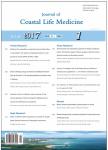Effect of some biological factors on the chitin yield of two crustacean species inhabiting the Egyptian waters
Effect of some biological factors on the chitin yield of two crustacean species inhabiting the Egyptian waters作者机构:Biotechnology Institute for Postgraduate and ResearchesSuez Canal University41522IsmailiaEgypt Department of Marine ScienceFaculty of ScienceSuez Canal University41522IsmailiaEgypt Department of Marine ScienceFaculty of SciencePort Said University42511Port SaidEgypt Department of ChemistryFaculty of ScienceSuez Canal University41522IsmailiaEgypt Department of MicrobiologyFaculty of PharmacySuez Canal University41522IsmailiaEgypt
出 版 物:《Journal of Coastal Life Medicine》 (海岸生命医学杂志(英文版))
年 卷 期:2017年第5卷第11期
页 面:463-467页
学科分类:1002[医学-临床医学] 100214[医学-肿瘤学] 10[医学]
基 金:the Swedish International Development Cooperation Agency Sweden (Grant number 2009-6420)
主 题:Chitin yield Biological factors Erugosquilla massavensis Charybdis natator
摘 要:Objective: To investigate the chitin yield of two commercial crustacean species that are exploited in the Suez Canal region, the Red Sea crab Charybdis natator (C. natator) and the Mediterranean mantis shrimp Erugosquilla massavensis (E. massavensis), and to assess the effect of some biological factors such as sex, size and maturity stages of females ovaries on this yield. Methods: A total of 64 specimens of crabs were collected from the Red Sea and 1377 mantis shrimps were collected from the Mediterranean Sea. Chitin was obtained after the de-proteinization, de-mineralization and de-colorization of 5 g oven dried exoskeletons and values were expressed as g/5 g and percentages. Results: Chitin yield was significantly higher in E. massavensis than C. natator (22.1%, 14.22%, respectively). No significant difference in the yield was recorded between males and females of C. natator (12.9%, 14.9%, respectively), while the yield in E. massavensis males was significantly higher than females (25.3%, 21.2%, respectively). Significant variations in the chitin yield were observed between the different sizes of E. massavensis with the maximum being from the individuals falling in the size range 90–130 mm body length. The yield was at its lowest in the immature stage of C. natator females ovaries (9.29%). However, the values increased and remained constant for the remaining stages (≥ 18%). Conclusions: The study recommends the use of the mantis shrimp for the production of chitin on commercial scale particularly medium sized males.



